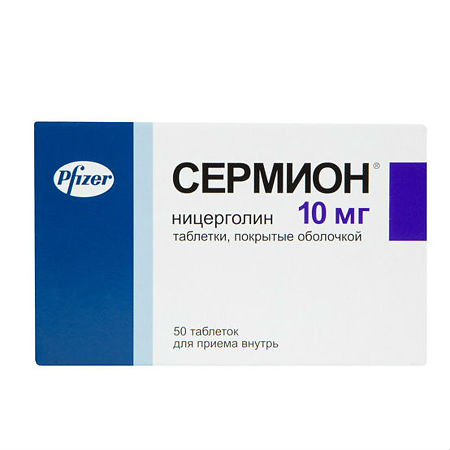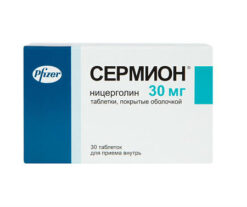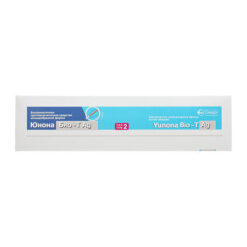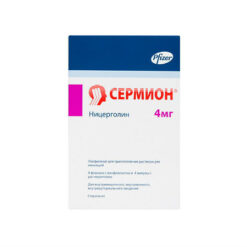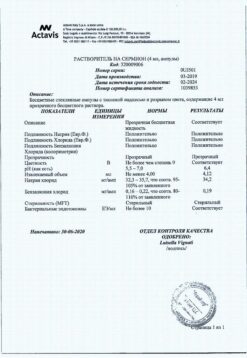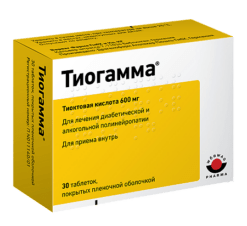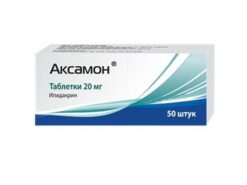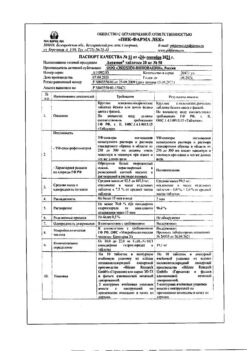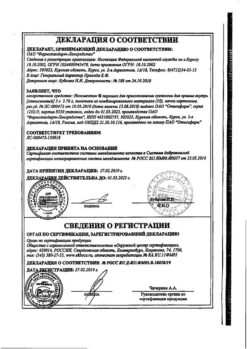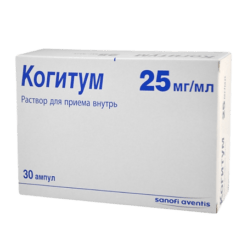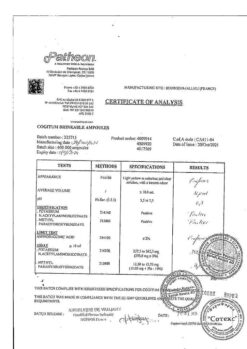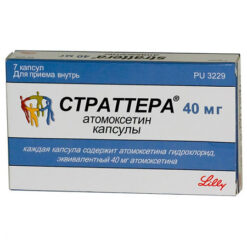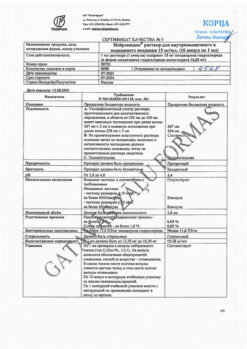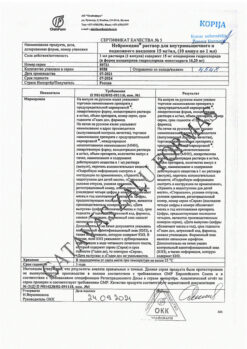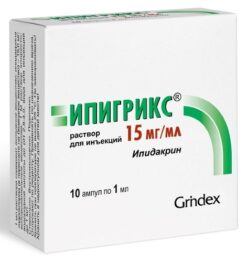No products in the cart.
Sermion, 10 mg 50 pcs.
€23.16 €21.86
Description
Pharmacodynamics
A drug that improves cerebral and peripheral blood flow, with alpha-adrenoblocking as well as metabolism-activating effects.
Limits vascular resistance, increases arterial blood flow and oxygen and glucose consumption by brain tissue. Lowers pulmonary vascular resistance. Reduces platelet aggregation and improves hemorheological indicators.
Enhances blood flow velocity in the blood vessels of the upper and lower extremities, especially in blood flow disorders caused by functional arteriopathy. Clinical trials have shown high effectiveness of Sermion in disorders of cerebral circulation and insufficiency of arterial blood flow in the vessels of the upper and lower extremities.
The administration of Sermion in therapeutic doses generally has no effect on BP. In patients with arterial hypertension, the drug may cause a gradual decrease in BP.
Pharmacokinetics
There have been no studies of the pharmacokinetics of Sermion.
Indications
Indications
Symptomatic treatment of cognitive impairment, including dementia, in chronic cerebrovascular and organic brain lesions, accompanied by decreased memory, concentration, thinking, activity, increased fatigue, and emotional disorders.
Note: before starting treatment with nicergoline, you must make sure that these symptoms are not a manifestation of another disease (such as internal diseases, psychiatric or neurological diseases) and do not require specific therapy.
Pharmacological effect
Pharmacological effect
Nicergoline, an ergoline derivative, improves metabolic and hemodynamic processes in the brain, reduces platelet aggregation and improves hemorheological parameters of the blood. Nicergoline increases cerebral blood flow and oxygen consumption, and also improves the electroencephalogram (EEG), especially in hypoxic and ischemic syndromes. Nicergoline exhibits an α1-adrenergic blocking effect, leading to improved blood flow and has a direct effect on the cerebral neurotransmitter systems – noradrenergic, dopaminergic and acetylcholinergic. With the use of the drug, the activity of the noradrenergic, dopaminergic and acetylcholinergic cerebral systems increases, which helps to optimize cognitive processes. As a result of long-term therapy with nicergoline, there is a persistent improvement in cognitive functions and a decrease in the severity of behavioral disorders associated with dementia.
After oral administration, nicergoline is quickly and almost completely absorbed. The main metabolic products of nicergoline are 1,6-dimethyl-8β-hydroxymethyl-10α-methoxyergoline (MMDL, a hydrolysis product) and 6-methyl-8β-hydroxymethyl-10α-methoxyergoline (MDL, a demethylation product by the CYP2D6 isoenzyme). The ratio of the area under the concentration-time curve (AUC) for MMDL and MDL after oral administration of nicergoline indicates a pronounced first-pass metabolism through the liver. After oral administration of 30 mg of nicergoline, maximum concentrations of MMDL (21 ± 14 ng/ml) and MDL (41 ± 14 ng/ml) were reached after approximately 1 and 4 hours, respectively, then the concentration of MDL decreased with a half-life of 13–20 hours. Studies confirm the absence of accumulation of other metabolites (including MMDL) in the blood. Food intake or dosage form do not have a significant effect on the degree and rate of absorption of nicergoline. Nicergoline actively (> 90%) binds to plasma proteins, and the degree of its affinity for α1-acid glycoprotein is greater than for serum albumin. It has been shown that nicergoline and its metabolites can be distributed in blood cells. The pharmacokinetics of nicergoline when using doses up to 60 mg is linear and does not change depending on the age of the patient.
Nicergoline is excreted in the form of metabolites, mainly by the kidneys (approximately 80% of the total dose), and in small quantities (10-20%) through the intestines. In patients with severe renal failure, there was a significant decrease in the rate of excretion of metabolic products in the urine compared with patients with normal renal function.
Special instructions
Special instructions
Clinical studies have shown that with single or repeated use of nicergoline, a decrease in systolic and, to a much lesser extent, diastolic blood pressure can be observed in patients with normal values and with high blood pressure. These results may vary as other studies have not shown changes in systolic or diastolic blood pressure values.
An association with fibrosis (eg, pulmonary, cardiac, valvular, and retroperitoneal) has been noted with the use of ergot alkaloids that have 5HT2β serotonin receptor agonist activity.
Symptoms of ergotism (including nausea, vomiting, diarrhea, abdominal pain, and peripheral vasoconstriction) have been reported with certain ergot alkaloids and their derivatives. Doctors should be aware of the possible symptoms of ergot drug overdose before prescribing this class of drugs.
Active ingredient
Active ingredient
Nicergoline
Composition
Composition
Active ingredient: nicergoline 10.0 mg
Excipients: calcium hydrogen phosphate dihydrate 94.30 mg, microcrystalline cellulose PH101 22.40 mg, magnesium stearate 2.00 mg, carmellose sodium 1.30 mg;
shell: sucrose 33.40 mg, talc 10.90 mg, acacia resin 2.70 mg, sandarac resin 1.00 mg, magnesium carbonate 0.70 mg, titanium dioxide (E171) 0.70 mg, rosin 0.60 mg, carnauba wax 0.06 mg.
Pregnancy
Pregnancy
Due to the lack of special studies, Sermion® is contraindicated during pregnancy. While taking the drug, you must stop breastfeeding, since nicergoline and its metabolic products pass into mother’s milk.
Contraindications
Contraindications
Recent myocardial infarction, acute bleeding, severe bradycardia, orthostatic hypotension, hypersensitivity to nicergoline, other ergotamine derivatives or other components of the drug, sucrase/isomaltase deficiency, fructose intolerance, glucose-galactose malabsorption, age under 18 years, pregnancy, breastfeeding.
Side Effects
Side Effects
The following table lists adverse drug reactions (ADRs) categorized by standard system organ classes (SOCs) in order of decreasing medical severity or clinical significance within each frequency and SOC category.
Very common ≥ 1/10
Often ≥ 1/100 and < 1/10
Uncommon ≥ 1/1000 and < 1/100
Rarely ≥ 1/10000 and < 1/1000
Very rare <1/10000
Frequency unknown (cannot be determined from available data)
Mental disorders
Uncommon – Anxiety, confusion, insomnia
Nervous system disorders
Uncommon – Drowsiness, dizziness, headache
Frequency unknown – Feeling of heat(a)
Vascular disorders
Uncommon – Hypotension, hyperemia
Gastrointestinal disorders
Often – Unpleasant sensations in the abdomen
Uncommon – Diarrhea, nausea, constipation
Disorders of the skin and subcutaneous tissues
Uncommon – Itching
Frequency unknown – Rash(a)
General disorders and disorders at the injection site
Frequency unknown – Fibrosis(a)
Laboratory instrumental data
Uncommon – Increased level of uric acid in the blood
(a) The incidence of ADRs was assessed based on data obtained from studies described in the comprehensive safety summary (treatment-emergent ADRs, any causality). This pooled safety analysis included data from 8 double-blind controlled studies in patients with mild to moderate dementia, 1246 of whom received nicergoline. The “rule of three” was not applied because the data reported in the comprehensive safety summary (CSS) were obtained from nicergoline in a population of fewer than 3000 patients.
Interaction
Interaction
Sermion® should be used with caution in combination with the following drugs. Antihypertensive drugs: nicergoline may enhance the effect of antihypertensive drugs. Nicergoline may enhance the effect of beta-blockers on the heart. Sympathomimetic drugs (alpha and beta): nicergoline may inhibit the vasoconstrictor effects of sympathomimetic drugs due to its alpha-blocking action.
Drugs metabolized by the CYP2D6 enzyme: nicergoline is metabolized by the CYP2D6 isoenzyme, so the possibility of its interaction with drugs that are metabolized by the same enzyme cannot be excluded.
Antiplatelet agents and anticoagulants (for example, acetylsalicylic acid): nicergoline enhances the effect of these compounds on hemostasis, so bleeding time may increase.
Drugs affecting uric acid metabolism: due to the fact that nicergoline may increase the asymptomatic increase in serum uric acid levels.
Overdose
Overdose
Symptoms: transient pronounced decrease in blood pressure. Special treatment is usually not required; the patient just needs to take a horizontal position for a few minutes.
In exceptional cases, in case of severe disruption of the blood supply to the brain and heart, it is recommended to administer sympathomimetic drugs under constant blood pressure monitoring.
Storage conditions
Storage conditions
At a temperature not higher than 25°C.
Keep out of the reach of children.
Shelf life
Shelf life
3 years
Manufacturer
Manufacturer
Pfizer Italy S.r.L., Italy
Additional information
| Shelf life | 3 years. |
|---|---|
| Conditions of storage | Store at a temperature not exceeding 30 ° C. |
| Manufacturer | Pfizer Italy S.r.l., Italy |
| Medication form | pills |
| Brand | Pfizer Italy S.r.l. |
Other forms…
Related products
Buy Sermion, 10 mg 50 pcs. with delivery to USA, UK, Europe and over 120 other countries.

